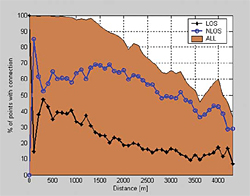
 |
| Probability of line of sight and non-line of sight connection vs. distance, London 5.8Ghz |
Sasha Williamson, CEO, Urban Wimax takes readers through a beginners guide to WiMAX
Westminster now boasts a WiMAX network, a standards-based wireless technology that provides high-throughput symmetrical broadband connections over long distances.
The flavour of WiMAX available today is fixed wireless, providing primary data and advanced voice connections that are symmetrical, low cost, and with a high service level agreement. Sasha Williamson, CEO of Urban Wimax, the first company to roll-out standards-based WiMAX services in the UK gives the lowdown on WiMAX.
The fixed WiMAX standard is 802.16d 2004. Designed with
the drawbacks of WiFi top of mind, 802.16d is highly secure, incredibly scaleable, predictable and stable.
We are currently offering fixed wireless, however WiMAX itself is so flexible that it can be marketed for WiFi backhaul and even, in the future, portability and mobility.
What does it do?
WiMAX is an incredibly intelligent network technology that can support many different types of service, from videoconferencing through remote applications to web surfing, all at a high quality of service.
The fixed version will be used to replace an Ethernet or SDSL connection with a high-speed symmetrical connection at 50 - 70% the cost of comparable services.
It is a compelling proposition for businesses looking for a robust, cost effective and secure connection without any dependence on the incumbent, BT (and the obvious advantages this brings in terms of guarantees for services levels, and opportunities for price control). At Urban Wimax we are addressing the SMEs needs with WiMAX – something that has been ignored for a while now. SMEs need primary data and advanced voice connections that are symmetrical, low cost, and with a high service level agreement. Unfortunately for them, with DSL SMEs are currently often stuck using consumer-grade services making it hard for them to compete with their larger competitors.
What makes WiMAX so great?
WiMAX is an incredibly clever and flexible technology. The standard has been defined in such a way that it can actually do more than both fixed and mobile networks. Although many people see it as a high capacity over a short range, with non-line of sight it can achieve a high capacity over a reasonably large range.
For our business model, one of the best advantages of WiMAX is the independence it gives you from the incumbent, meaning we offer businesses a resilient connection to preserve their mission critical applications in the event of incumbent’s failure.
What’s the drawback?
The number one issue that most service providers will encounter with WiMAX is that of non-line of sight and line of sight connections. The standard has the capability to provide non-line of sight coverage, however to be able to make use of this feature you have to possess highly detailed information on the physical environment and the impact it will have on the signal propagation.
Without this understanding in an urban environment, vendors can find the range and capacity of any WiMAX connection dropping to the point that it is just not marketable. When this happens, WiMAX loses all its advantages – and can risk becoming an expensive and embarrassing mistake. The main problems that operators need to solve are understanding customer connectivity, ubiquitous urban networks for addressable market share whilst lowering capex and operating costs by circa 20-30%.
It took 10 years R&D to produce the advanced mapping software that solves the issue of non-line of sight WiMAX for us. Using this, it is possible to assess the capacity that can be offered to any customer without sending out an engineer to test a line at a local exchange. It even makes it possible to advise which side of any roof-top will provide the best signal and capacity for a customer, by evaluating the propagation of the signal through any particular path. This means that site audits are much less necessary and customer expectations for a service and application throughput can be set before it is delivered.
Who would buy WiMAX services?
Businesses who will want to look seriously at WiMAX are those who have high upload demands and a requirement for a watertight service level agreement. At the moment many smaller businesses are having to use services designed primarily for power-consumers, not businesses at all, and the needs of a business differ dramatically from those of a consumer.
While consumers are still primarily downloading information, in the business environment a considerable amount of data flows the other way. Being able to upload at speed can make a tremendous difference to the way smaller companies conduct their business.
Businesses that have application needs such as sending large files, voice, video, CCTV security, on-line data back-up, ecommerce, FTP, VPN and ondemand applications are driving this market for symmetrical Internet connectivity and converged, advanced voice solutions.
WiMAX has the capability to change the networking landscape – rather disruptive while at the same time highly compatible with the needs of businesses. I think you will agree it will definitely be one to watch!
| www.urbanwimax.co.uk |
